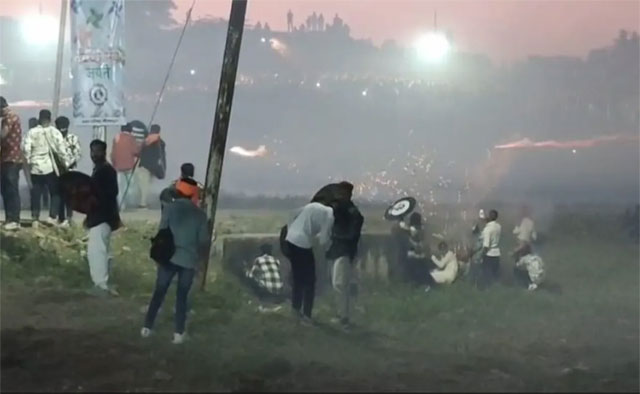Daijiworld Media Network - Indore
Indore, Oct 22: Over 35 people, including several minors, suffered burn injuries during the explosive Hingot War, a fiery post-Diwali tradition held in Gautampura, near Indore. The dramatic event, steeped in history and local pride, once again sparked both awe and concern on Tuesday evening.
Despite the presence of police, ambulances, and fire brigades, the centuries-old mock battle led to numerous injuries, though most were reported to be minor. Medical teams provided immediate aid at the site, according to district officials.
The Hingot War is no ordinary festival — it’s a battle reenactment between two rival factions: the Turra team of Gautampura and the Kalangi team from Runji. Positioned roughly 200 feet apart near the Devnarayan Temple, participants don traditional warrior attire, arm themselves with bamboo sticks, and hurl flaming Hingots — hollowed-out fruits filled with gunpowder — at each other in a symbolic show of valor.

This year’s clash was cut short by 30 minutes due to heightened safety concerns, as authorities tried to contain the escalating risks associated with the fiery exchange.
With roots believed to stretch back to the Mughal era, the Hingot War is thought to have evolved from guerrilla tactics used by Maratha soldiers.
According to local lore, Gurjar warriors first crafted Hingots as improvised explosives, later transforming them into a ceremonial weapon of honor.
Even today, the ritual draws enthusiastic participation from local youth, many of whom view it as a rite of passage — a dangerous but thrilling homage to their warrior ancestors.
The Hingot fruit itself plays a central role in the event. Once dried, its tough shell is hollowed out, packed with gunpowder, and sealed with yellow clay — turning it into a fireball ready to be launched.
Though the festival is a proud tradition in the region, its intensity continues to raise concerns about participant safety. Still, for many in Gautampura, the Hingot War remains a powerful symbol of bravery, identity, and cultural legacy.